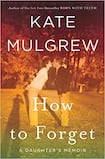
You might have heard of Kate Mulgrew. She played Capt Kathryn Janeway on Star Trek: Voyager, and “Red” on Orange Is the New Black. You won’t have heard of Thomas James Mulgrew or Joan Kiernan, her parents, whom How to Forget, her second memoir, is about.
On the front cover, two figures, presumably Tom and Joan, are pictured leaning into a kiss. Tom stands upright, hands by his sides, while Joan leans forward, hands behind her back. There is at least a foot of space between their bodies. Their lips are about an inch apart. Their shadows extend into the background, which is a copse of trees, leaves scattered over the ground. Another shadow extends, too: that of the person taking the photograph. Within the book, on the reverse side of the first page, is another photograph, this time of a lonely patch of trees. There are no people, or shadows.
Tom died of lung cancer in 2004, and Joan followed two years later, having suffered with Alzheimer’s. How to Forget is about Kate’s experience returning to her hometown of Dubuque, Iowa, and caring for her parents in their final years.
This story will feel familiar to anyone who has cared for elderly relatives. It resides in that trench of time where you might be working, visiting, not sleeping, possibly feeding, bathing, bringing to the toilet, trying to decide what “the best thing” is, wishing for the end and then realising, guiltily, what that means. Death is in the opening three words of this book – “He died first” – and permeates throughout.
A phone call to Kate about her father’s illness sets the narrative in motion, and from then we are in a narrow funnel, converging towards the inevitable. But the funny thing about a situation such as that is that the closer the person gets to their endpoint, the more the enormity of their life seems to fan out behind them. They are their whole history, and they are a small, incapable child.
When Kate receives that call, she is in her dressingroom, preparing for a performance. The play is Tea at Five, a one-woman biodrama in which she plays Katharine Hepburn in both her youth and her dotage. This is an impressive trick, and in the book she pulls off a similar one; vacillating between time periods.
She conveys her young mother flaunting around New York with Jean Kennedy Smith, her young father driving his daughter to an audition, the whole, young, family, sitting around the kitchen table – and then, minutes later, her elderly parents being bathed, forgetting names, lying still in a bed. This technique allows for a full, wide-spanning narrative, and one which includes stark family truths, but for the reader there is always the sense of being stuck in the “now”, that slow space where an ice cube might be melting in a glass, a cigarette carefully lit, or a clock faintly ticking.
Melancholy
If this sounds like a sad book, it is. It is slow and melancholy. The writing is at times overwrought, saturated with detail. But it is also poetic and at times whimsical. As her primary source, Kate consulted a portfolio of poems and letters her father had written to her mother. This, along with the cover photo, suggests a love story.
But if it is a love story, it is a fractured one. Tom and Joan each get a separate section within the book. There is a sad distance between their lives. And then there is Kate, taking the photo, oddly implicated in that distance, and at her own distance, too: the Hollywood star, who “was always just passing through”.
So we get the sense, as we read, of things missing, forgotten, unsaid. We might be looking at a kiss, but what we are really seeing is a gap.
Did I enjoy the book? There is a scene, towards the end, where Kate and her ill mother convince a neighbour to allow them see inside her house. The place is immaculate: with white carpets, a gleaming utility room, fresh-baked cookies. But when they attempt to peek into one of the bedrooms, the neighbour declines: “[T]he beds aren’t even made and Doug – that’s my husband – he’s got his stuff lying around”.
She has a point. There’s no reason why she should show them her messy rooms. But in Mulgrew’s book, she shows us all the rooms. We look closely at every dust mite, every toenail. I walked right in and wandered around, touching things. I wanted to keep looking.











